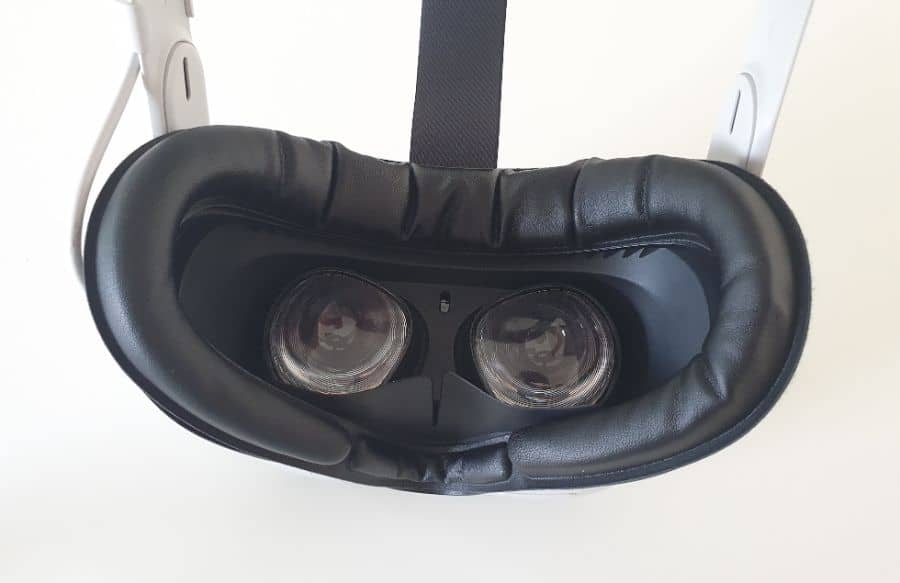
For those who want to get the most out of their Quest 2, there are a few important upgrades that can make a big difference to your experience. Choosing the right facial interface can be a game-changer, and I’ve recently been testing the Kiwi Design Upgraded Fitness Facial Interface for Quest 2 to see if it is a good choice for those looking for a better-performing facial interface.
This article is going to cover my experience of using the Kiwi Design Fitness Facial Interface For Quest 2, highlighting both its strengths and areas that need some improvement.
First Impressions
Unboxing the Kiwi Design Fitness Facial Interface for Quest 2, I was impressed with the quality of the components and the selection of accessories that it comes with. The following are included in the box;
- One vented plastic facial gasket with rubber nasal seal
- Two PU leather-covered face cushions
- One cloth-covered foam face cushion
- One glasses spacer
- One cotton lens protector
Holding the replacement facial interface in my hands, the build quality felt solid and durable. The PU leather was notably soft to the touch, and the thick foam padding is nice and thick, at 0.63”, without being excessive and impacting the FOV. Meanwhile, the vents were subtle and integrated seamlessly into the overall design. The plastic facial gasket looks really good, and I definitely think it improves the look of my Quest 2 overall.
I was pleased that the facial interface came with three different face cushions, two of which have a sweat-resistant PU leather cover. The other has a cloth covering over foam. Both are good options for when working out in VR. The PU leather is easily wiped clean but does tend to feel more sweaty when in use. The face cushion with the material covering lets sweat soak into the foam, which some people prefer, but the downside is that this often needs to dry out after a particularly vigorous VR gaming session, and will need rinsed or washed fairly frequently.
The rubber nose flap that reduces light leak is another feature that stood out immediately. It’s an issue that’s often overlooked but can significantly impact a user’s VR experience. The Quest 2 has quite a lot of light leak around the nose for me, and while this has its pros and cons, I generally prefer to be completely enclosed in VR to maximize the immersion.
Putting on my Quest 2 with the Kiwi Design facial interface resulted in very little light leak apart from a small amount that was apparent from the air vents, but overall, it improves greatly on the default facial interface.
The glasses spacer that is included is another thoughtful touch, but one that is really important for glasses wearers, to ensure they have enough space between their eyes and the lenses of the Quest 2 to be able to wear their glasses without scratching the lenses.
I also liked the lens protector that is included with the Kiwi Design Fitness Facial Interface For Quest 2. The lenses of the Quest 2 are made of plastic and are quite delicate and prone to scratches, so protecting them with a foam cover is a sensible idea when you are not using, or transporting your headset.
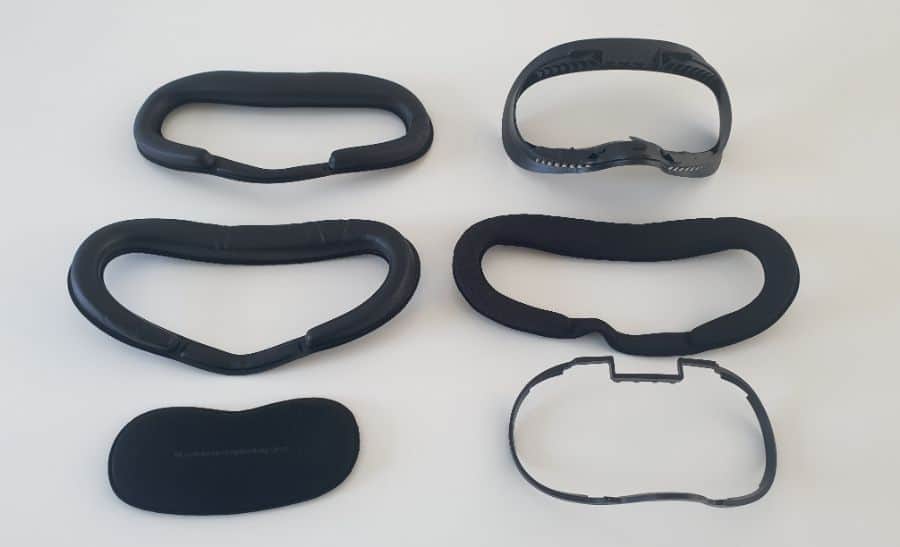
Features
Let’s run through some of the main features of the Kiwi Design Fitness Facial Interface For Quest 2.
- Replacement Facial Interface: The product is designed as a replacement for the original Oculus Quest 2 facial interface.
- Vent Design: The Kiwi Design Fitness Facial Interface has a vented design to improve ventilation around your face while using your Quest 2, to keep you cooler and reduce lens fogging.
- Fitness-oriented Foam Padding: It comes with three facial cushions, two covered with PU leather and one covered with material. Each one has thick foam padding to improve comfort for extended or physically active use.
- Anti-leakage Nose Pad: The design includes an anti-leakage nose pad intended to block light from entering.
- Easy Cleaning: The foam padding and facial interface are both designed to be easily cleaned, possibly enhancing the overall user experience.
You can purchase the Kiwi Design Fitness Facial Interface For Quest 2 from the Kiwi Design store or from Amazon.
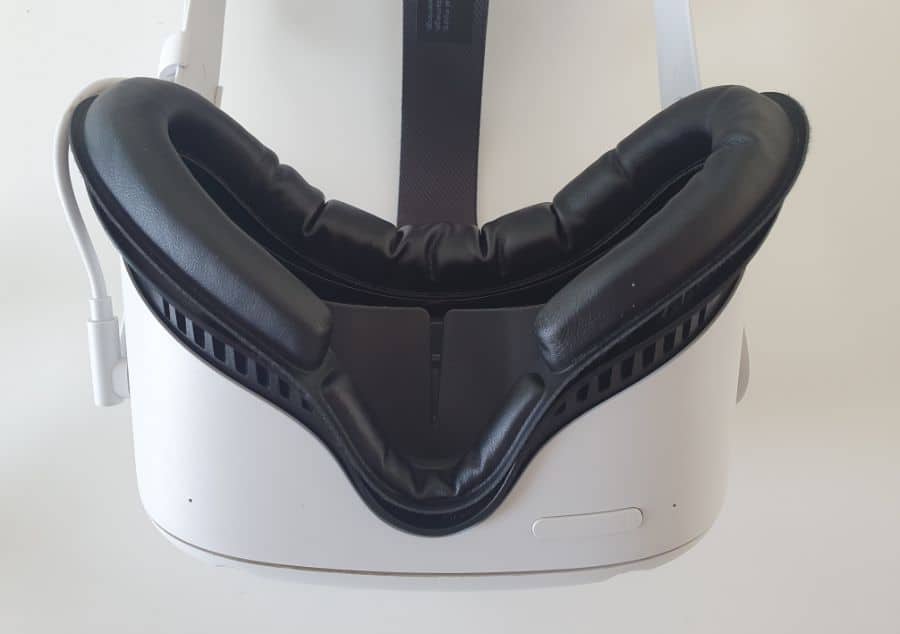
Design And Features
The Kiwi Design Fitness Facial Interface for Quest 2 aims to address some common issues with the standard Quest 2 facial interface, particularly for those who enjoy working out in VR, where sweat build-up and heat are particular issues.
The facial bracket is made of plastic and is light, but solid, within only a small amount of flex when stressed. The anti-leakage nose pad works really well to increase immersion, enhancing your focus on the virtual world. The face gasket also has air vents along the lower part, designed to improve airflow around your face while using the headset.
The fitness interface comes with three face cushions that replace the original foam interface of your Quest 2, offering a more comfortable fit. Two of them are covered with PU leather and feel incredibly soft. They are waterproof, making them easy to wipe clean after use. They have velcro along the entirety of the back of the pad, allowing you to precisely fit it to the plastic face gasket. The PU leather covers foam padding that is 0.63 inches thick, ensuring the cushion feels comfortable against your face.
The other face cushion has a fabric cover that is more in keeping with the original Quest 2 face pad, but the Kiwi Design one is a bit softer and thicker. It also has thick foam padding and feels soft and durable. The porous fabric material allows sweat to be absorbed into the face cushion, which prevents it from fogging up the headset lenses and provides a more comfortable user experience. The padding fits snugly on the facial interface, creating a comfortable and immersive VR experience.9
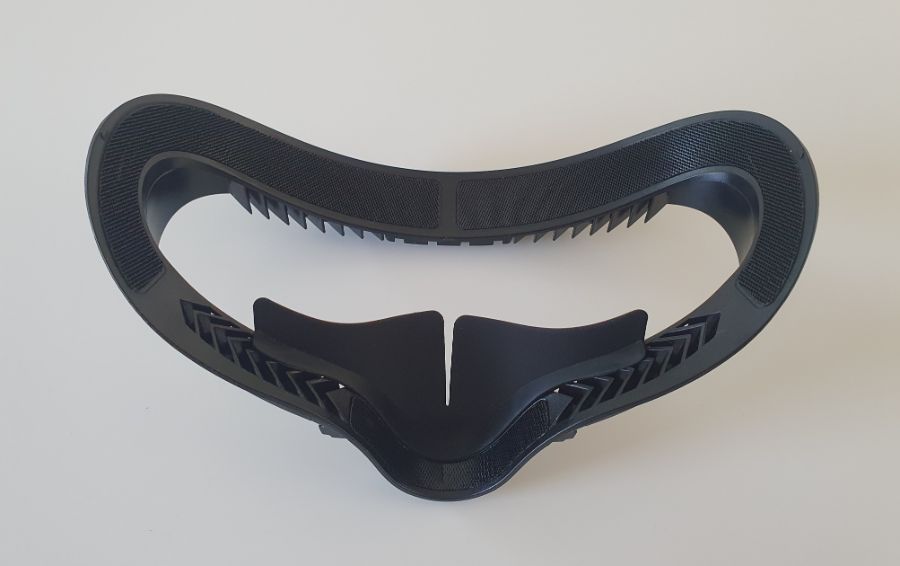
Performance
Having put the Kiwi Design Fitness Facial Interface for Quest 2 to the test over the last few weeks, I’ve generally been impressed by how it has performed, and it is undoubtedly better than the original Quest 2 interface in most ways. I’ve tried to push this facial interface to the limit by doing a number of prolonged, high-tempo workouts to see if it can help prevent lens fog, and keep me cooler than when using the original face pad – I’m pleased to say that it performs very well overall.
The face covers have their pros and cons. Whilst the PU leather covers feel amazing against your face, they are waterproof, so you do feel more sweaty while using them, and they tend to cause more noticeable red marks on my face after prolonged use. However, they can be wiped clean in a few seconds and can be hygienically shared with other users.
The fabric-covered facial cushion wicks any sweat away from your face and it is absorbed into the foam, and this helped me stay a bit more cool and comfortable while using it, but the downside is that the foam can get wet and sweaty after an intense workout, and you will want to let it dry before using it again, and wash it as needed.
Each of the facial cushions has retained shape very well despite intense and prolonged use. The PU leather looks as good as new, and the fabric face cushion still looks pretty clean.
The vents along the lower end of the face gasket do improve airflow, but this is countered by the reduced airflow caused by the rubber nose seal. Overall, I much prefer this to the default facial interface as it excludes more light, but the increase in ventilation is fairly modest.
I have noticed some lens fog while using the Kiwi design facial interface, but it has rarely been bad enough that I would have to stop playing and wipe the lenses. Lens fog usually happens when the lenses are cold but your face is hot and sweaty. As the lenses heat up, and the air around the lenses is exchanged via the ventilation points, fogging tends to reduce over the space of a few minutes.
Lens fog is largely a function of the amount of ventilation around the lenses, and this facial interface strikes a good balance between light exclusion and ventilation. One of my other VR headsets, the HP reverb G2 has a completely sealed facial interface, with no light leak, but no ventilation either, and this tends to cause quite a bit of troublesome lens fog.
The anti-leakage nose pad’s performance stands out too. The design effectively blocks out external light, providing a more immersive VR experience. Even in brightly lit rooms, it ensures minimal light leakage into the headset, maintaining immersion in the virtual world. I am aware of a faint bit of light leak at the sides, but this is very significantly reduced from using the default facial interface and does not cause a problem during use of the Quest 2.
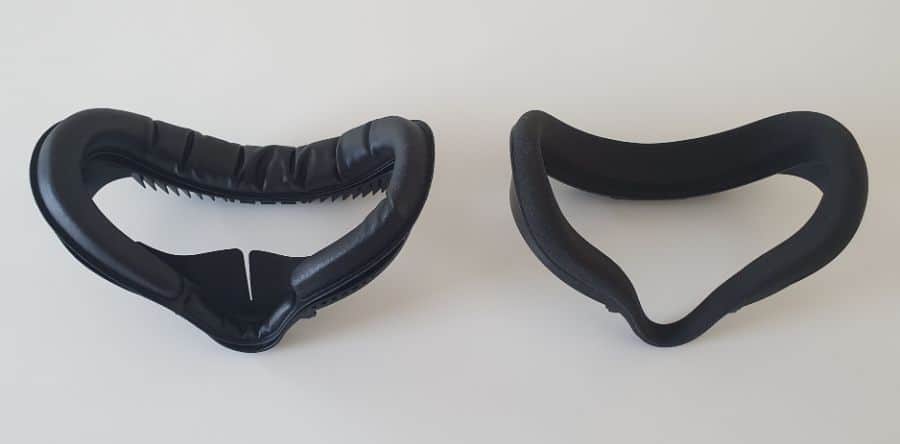
What I Like About The Kiwi Design Fitness Facial Interface For Quest 2
Overall, I’m a big fan of the Kiwi Design Fitness Facial Interface for Quest 2. It offers a lot of benefits over the original Quest 2 facial interface, with significant improvements to comfort, light leak, and ventilation. The PU-covered facial cushions are amazing to use and the ability to wipe them clean is so much more practical than having to use a soggy foam face cushion that needs to dry out every time you have a VR workout.
The anti-leakage nose pad performs exceptionally well in enhancing immersion. It effectively blocks out external light, creating an ideal VR environment even in bright ambient conditions. This feature sets the Kiwi Design interface apart from many other products on the market.
The glasses spacer is also a very welcome addition and an important feature for anyone who normally wears glasses while using their Quest 2.
What Needs To Be Improved
Despite the Kiwi Design Fitness Facial Interface for Quest 2’s many great features, there are a few areas that could use some improvement to make it an even more complete offering.
The facial cushions attach to the face gasket with velcro, and it’s pretty tricky to line them up correctly and position the face cushion without having it stick in the wrong place. This leads to it taking a minute or two to change the face cushion each time, which isn’t ideal if you need to switch back and forth, such as when taking turns on the headset with a friend where you each want to use a different facial cushion.
Secondly, while the vent design works well and is efficient for defogging, it does come with the trade-off of allowing some light into the headset. For those who like complete immersion and no light leak at all, you may find this a bit disappointing. Personally, as the amount of light leak is substantially less than the default facial interface, I’m more than happy with the amount of light leak.
Conclusion
Overall, I’ve been really impressed with the Kiwi Design Fitness Facial Interface for Quest 2. It’s way better than the original facial interface and is a great option for anyone who regularly works out using their Quest 2, or for those who just want an upgraded facial interface. It’s not the cheapest facial interface you can purchase, but I do feel it offers good value, and it’s now become the facial interface I use on a daily basis.
You can purchase the Kiwi Design Fitness Facial Interface for Quest 2 from the Kiwi Design store or from Amazon.
